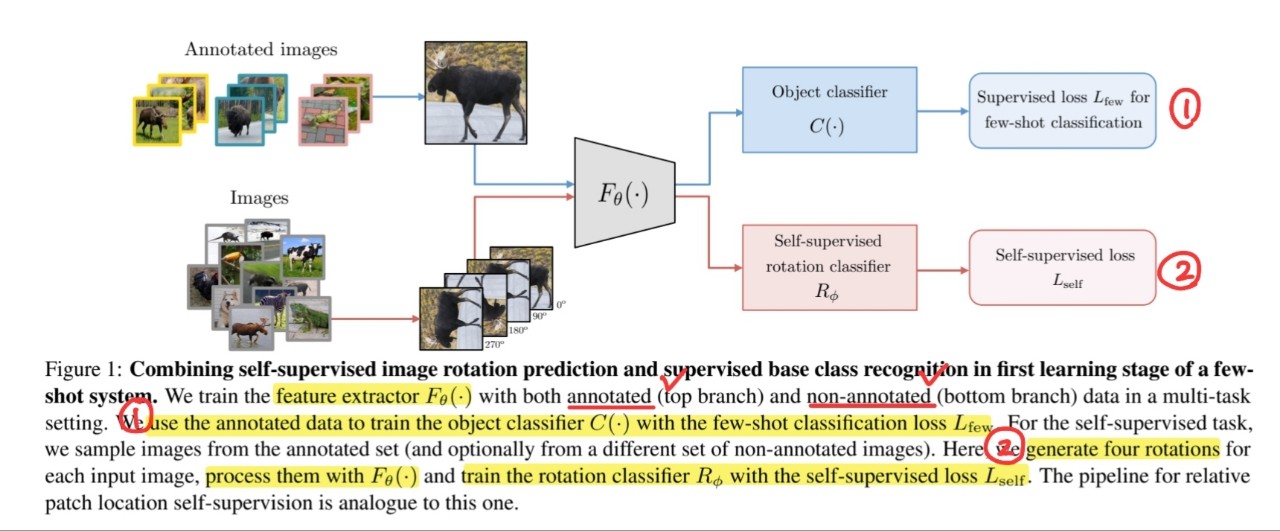Boosting Few-Shot Visual Learning with Self-Supervision
Contents
- Abstract
- Related Work
- Few-shot Learning
- Self-supervised Learning
- Methodology
- Explored few-shot learning methods
- Boosting few-shot learning via self-supervision
0. Abstract
Few-shot Learning & Self-supervised Learning
- common : how to train a model with little / no-labeled data?
Few-shot Learning :
- how to efficiently learn to recognize patterns in the low data regime
Self-supervised Learning :
- looks into it for the supervisory signal
\(\rightarrow\) this paper exploits both!
1. Related Work
(1) Few-shot Learning
- Gradient desent-based approach
- Metric learning based approach
- Methods learning to map TEST example to a class label by accessing MEMROY modules that store TRAINING examples
This paper : considers 2 approaches from Metric Learning approaches
- (1) Prototypical Network
- (2) Cosine Classifiers
(2) Self-supervised Learning
- annotation-free pretext task
- extracts semantic features that can be useful to other downstream tasks
This paper : considers a mutli-task setting,
- train the bacbone convnet using joint supervision from the supervised end-task
- and an auxiliary self-supervised pretext task
\(\rightarrow\) self-supervision as an auxiliary task will bring improvements
2. Methodology
Few-shot learning : 2 learning stages ( & 2 set of classes )
Notation
-
Training set
- of base classes ( used in 1st stage ) : \(D_b=\{(\mathrm{x}, y)\} \subset I \times Y_b\)
- of \(N_n\) novel classes ( used in 2nd stage ) : \(D_n=\{(\mathbf{x}, y)\} \subset I \times Y_n\)
- each class has \(K\) samples ( \(K=1\) or 5 in benchmarks )
\(\rightarrow\) \(N_n\)-way \(K\)-shot learning
-
label sets \(Y_n\) and \(Y_b\) are disjoint
(1) Explored few-shot learning methods
Feature Extractor : \(F_\theta(\cdot)\)
-
Prototypical Network (PN), Cosine Classifiers (CC)
( difference : CC learns actual base classifiers with feature extractors, while PN simply relies on class-average )
a) Prototypical Network (PN)
[ 1st learning stage ]
-
feature extractor \(F_\theta(\cdot)\) is learned on sampled few-shot classification sub-problems
-
procedure
-
subset \(Y_* \subset Y_b\) of \(N_*\) base classes ( = support classes ) are sampled
- ex) cat, dog, ….
-
for each of them, \(K\) training examples are randomly picked from within \(D_b\)
- ex) (cat1, cat2, .. catK) , (dog1, dog2, … dogK)
\(\rightarrow\) training dataset \(D_*\)
-
-
prototype : average feature for each class \(j \in Y_*\)
- \(\mathbf{p}_j=\frac{1}{K} \sum_{\mathbf{x} \in X_*^j} F_\theta(\mathbf{x})\), with \(X_*^j=\left\{\mathbf{x} \mid(\mathbf{x}, y) \in D_*, y=j\right\}\)
-
build simple similarity-based classifier with prototype
Output ( for input \(\mathbf{x}_q\) ) :
-
for each class \(j\) , the normalized classification score is…
\(C^j\left(F_\theta\left(\mathbf{x}_q\right) ; D_*\right)=\operatorname{softmax}_j\left[\operatorname{sim}\left(F_\theta\left(\mathbf{x}_q\right), \mathbf{p}_i\right)_{i \in Y_*}\right]\).
Loss function ( of 1st learning stage ) :
- \(L_{\mathrm{few}}\left(\theta ; D_b\right)=\underset{\substack{D_* \sim D_b \\\left(\mathbf{x} q, y_q\right)}}{\mathbb{E}}\left[-\log C^{y_q}\left(F_\theta\left(\mathbf{x}_q\right) ; D_*\right)\right]\).
[ 2nd learning stage ]
- feature extractor is FROZEN
- classifier of novel classes is defined as \(C\left(\cdot ; D_n\right)\)
- prototypes defined as in \(\mathbf{p}_j=\frac{1}{K} \sum_{\mathbf{x} \in X_*^j} F_\theta(\mathbf{x})\) with \(D_*=D_n\).
b) Cosine Classifiers (CC)
[ 1st learning stage ]
- trains the feature extractor \(F_\theta\) together with a cosine-similarity based classifier
- \(W_b=\left[\mathbf{w}_1, \ldots, \mathbf{w}_{N_b}\right]\) : matrix of the \(d\)-dimensional classification weight vectors
- output : normalized score for image \(x\)
- \(C^j\left(F_\theta(\mathbf{x}) ; W_b\right)=\operatorname{softmax}_j\left[\gamma \cos \left(F_\theta(\mathbf{x}), \mathbf{w}_i\right)_{i \in Y_b}\right]\).
Loss function ( of 1st learning stage ) :
- \(L_{\mathrm{few}}\left(\theta, W_b ; D_b\right)=\underset{(\mathbf{x}, y) \sim D_b}{\mathbb{E}}\left[-\log C^y\left(F_\theta(\mathbf{x}) ; W_b\right)\right]\).
[ 2nd learning stage ]
- compute one representative feature \(\mathbf{w}_j\) for each new class
- by averaging \(K\) samples in \(D_n\)
- define final classifier \(C\left(. ;\left[\mathbf{w}_1 \cdots \mathbf{w}_{N_n}\right]\right)\)
(2) Boosting few-shot learning via self-supervision

Propose to leverage progress in self-supervised feature learning to improve few-shot learning
[ 1st stage ]
-
propose to extend the training of feature extractor \(F_\theta(.)\),
by including self-supervised task
2 ways to incorporate SSL to few-shot learning
- (1) using an auxiliary loss function, based on self-supervised task
- (2) exploiting unlabeled data in a semi-supervised way
a) Auxiliary loss based on self-supervision
\(\min _{\theta,\left[W_b\right], \phi} L_{\text {few }}\left(\theta,\left[W_b\right] ; D_b\right)+\alpha L_{\mathrm{self}}\left(\theta, \phi ; X_b\right)\).
-
by adding auxiliary self-supervised loss in 1st stage
-
\(L_{\text {few }}\) : stands for PN few-shot loss / CC loss
Image Rotation
- classes : \(\mathcal{R}=\left\{0^{\circ}, 90^{\circ}, 180^{\circ}, 270^{\circ}\right\}\)
- network \(R_\phi\) predicts the rotation class \(r\)
- \(L_{\text {self }}(\theta, \phi ; X)=\underset{\mathbf{x} \sim X}{\mathbb{E}}\left[\sum_{\forall r \in \mathcal{R}}-\log R_\phi^r\left(F_\theta\left(\mathbf{x}^r\right)\right)\right]\).
- \(X\) : original training set of non-rotated images
- \(R_\phi^r(\cdot)\) : predicted normalized score for rotation \(r\)
Relative patch location
-
divide it into 9 regions over 3x3 grid
- \(\overline{\mathrm{x}}^0\) : central image patch
- \(\overline{\mathrm{x}}^1 \cdots \overline{\mathrm{x}}^8\) : 8 neighbors
-
compute the representation of each patch
& generate patch feature pairs \(\left(F_\theta\left(\overline{\mathbf{x}}^0\right), F_\theta\left(\overline{\mathbf{x}}^p\right)\right)\) by concatenation.
-
\(L_{\mathrm{self}}(\theta, \phi ; X)=\underset{\mathbf{x} \sim X}{\mathbb{E}}\left[\sum_{p=1}^8-\log P_\phi^p\left(F_\theta\left(\overline{\mathbf{x}}^0\right), F_\theta\left(\overline{\mathbf{x}}^p\right)\right)\right]\).
- \(X\) : original training set of non-rotated images
- \(P_\phi^p\) : predicted normalized score for relative location \(p\).
b) Semi-supervised few-shot learning
- does not depend on class labels
- can obtain information from additional unlabeled data
- \(\min _{\theta,\left[W_b\right], \phi} L_{\mathrm{few}}\left(\theta,\left[W_b\right] ; D_b\right)+\alpha \cdot L_{\mathrm{self}}\left(\theta, \phi ; X_b \cup X_u\right)\).
